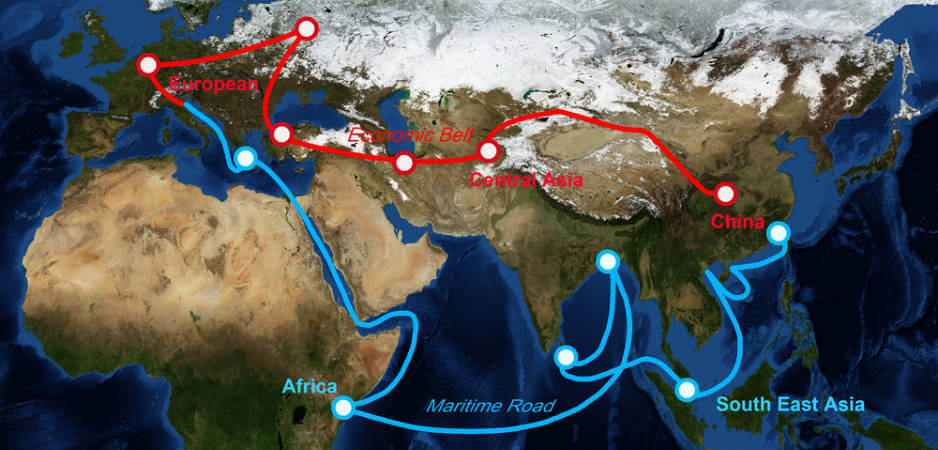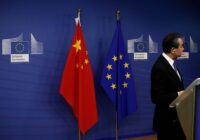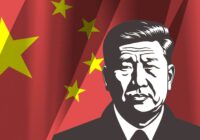India should keep the doors of engagement with China open to carve out a niche for itself in the One Belt, One Road initiative.
The old saying, “When the dragon sneezes, the world catches cold” has acquired a completely new meaning after the low-key announcement of the One Belt, One Road (OBOR) initiative by China’s President Xi Jinping in 2013. The cloak of secrecy has always been the characteristic feature of the Middle Kingdom and this has already disturbed the world of diplomacy and intelligence. Coupled with its increasingly assertive posture in the South China Sea, the OBOR initiative has come to be looked upon as a “silk glove for Chinese iron fist.”
In general, it has raised perceptible uneasiness among the leading world powers, but, in the case of India, the fears are alarming, as the dragon is spitting fire right in India’s backyard. India didn’t send a single embassy official to the recent OBOR summit in Beijing. The Ministry of External Affairs (MEA) of India stipulated that anyone from think tanks, business chambers and other ministries would have to get clearance if they were attending the forum.
Further, the MEA released a comprehensive statement questioning the sanctity and objectives of the initiative on the grounds that the OBOR initiative violates India’s territorial integrity because China-Pakistan Economic Corridor (CPEC) falls in Pakistan-Administered Kashmir, which is Indian territory. Secondly, the projects appear to have hidden motives, with soft loans that could trap smaller countries in a crushing debt cycle. There can be adverse effects on ecology and the environment, leading to the disruption the local communities.
New Delhi is also wary of China’s intentions and views the project with suspicion, tacitly accusing China of enhancing its global geopolitical influence under the veneer of expanding road networks and encircling India. Chinese investment and interference with India’s immediate neighbors like Nepal, Sri Lanka, Bangladesh and Myanmar lends a sense of immediate fear among the intelligence community and foreign policy mandarins of India.
String of Pearls
Closer analysis reveals that it is not just OBOR that has raised the fear in Indian strategic circles. In fact, these concerns have been accumulating since the days of what many Indian strategists refer to as the “String of Pearls.” The String of Pearls is a theory, popular in Indian strategic and intelligence circles, which argues that China is trying to cordon off India by spreading a network of dual-use ports connecting its eastern coast to the Middle East that would boost its strategic clout and maritime access.
India’s strategic community sees OBOR as nothing but the transformation of this “string of pearls” into a more systematic and deceptive strategy loaded with covert revanchist ambitions hidden under the cloak of economic development and shared prosperity. Brahma Chellany, India’s leading China expert, writes in The Japan Times: “Indeed, by working to establish its dominance along the major trade arteries, while instigating territorial and maritime disputes with several neighbors, China is attempting to redraw Asia’s geopolitical map.” Former Indian Foreign Secretary Shyam Saran sees OBOR as not just an economic initiative but one that has clear political and security implications — “a carving out by China of a continental-marine geostrategic realm.”
The central debate here is not whether India’s concerns are genuine or not. Given the history of conflict between the two countries and China’s all-weather friendship with Pakistan, the gravity of India’s concerns cannot be trivialized. However, the matter of importance here is India’s response to the grand designs of the Middle Kingdom.
The most pressing of India’s concerns is the implementation of CPEC on territory claimed by India amounting to the violation of the territorial integrity and sovereignty of India. It is indeed a genuine concern, but by not joining the initiative, India is giving Pakistan and China a free hand in Pakistan-Administered Kashmir — the so-called “disputed territory.” In a situation where India does not have an effective political control over the territory, leaving it open for a multilateral infrastructure project with a clear focus on transport corridors amounts to virtually giving a free rein to China and Pakistan. In due course, their stakes and economic and strategic foothold in the area will be so strongly entrenched that it will be virtually impossible for India to hold any claim. India will have a mere legal locus standi in that case, and when it comes to disputes where a large geographical area is involved, India must have a strong cultural, economic and social connection to the region and its people. These unofficial links will strengthen India’s foothold and provide substance to the claim in the future if the matter comes to legal negotiations.
In The Times of Central Asia, James Dorsey informs that a leaked long-term plan for China’s massive $56-billion investment in Pakistan exposes the goals of Beijing’s One Belt, One Road initiative as a “ploy for economic domination, the creation of surveillance states, and allowing China to influence media landscapes.” The leaked plan also revealed that a full system of monitoring and surveillance would be built in Pakistani cities to ensure law and order. The system will be based on an array of explosive detectors and scanners to “cover major roads, case-prone areas, and crowded places … in urban areas to conduct real-time monitoring and 24-hour video recording.”
The plan also outlines how Pakistan would be turned even more than it already is into a surveillance state where freedom of expression and the media are manipulated. It also suggested the degree to which OBOR is designed to establish China as Eurasia’s dominant power based on economics, as well as the adoption of measures that undermine democracy or inhibit political transformation in autocracies.
The leaked plan may not be a complete picture of China’s modus operandi, but it certainly unravels the subtle nuances of China’s hidden motives. And, if Chinese designs include surveillance, then India must foresee the possibility of highly sophisticated intelligence installations and activity in the neighborhood and Pakistan-Administered Kashmir. Such activities are hidden in nature and in the long term could be highly detrimental to India’s national interests. Therefore, it becomes all the more important to be part of this initiative, not for the reasons of morality or goodwill, but purely for the logic of statecraft and the protection of India’s national interests.
Transforming the Status Quo
Secondly, discounting all the nefarious designs and hidden motives, it cannot be denied that the OBOR initiative offers tremendous economic opportunities. The highways and rail links built in the highly volatile and sensitive region of Eurasia and the maritime routes will be the lifeline of international trade and commerce in the future. Staying away from such a grand project is like a self-imposed economic exile. In a globalized and interdependent world of today, this will be a blunder of Himalayan heights and will result in putting major hurdles in India’s economic growth and finally in isolation, both diplomatic as well as economic.
China has already hinted at this, though in the form of a mild threat. It must be recognized that at the core the OBOR initiative is a multilateral economic regime that has all the potential to herald a new breakthrough in the global trade and commerce and completely transform the postwar economic order. At this stage, China has made attempts to cajole India to join. The project is in a nascent state but, with time, China might grow stronger and capture the vantage points of this international economic regime. At that point, India will have no clout to control, regulate and manipulate the economic and geopolitical trends that emanate from the initiative. Hence, it becomes necessary to see beyond the petty issues of ego and minor interests of domestic electoral politics and join the initiative. The best way forward is to hop on the bandwagon and carve out a niche, chipping away at China’s clout. This is what the world powers are aiming at. US and Japan, though officially not part of the initiative, have sent their representatives. American companies have been awarded big contracts in CPEC.
Further, India has nothing to fear. While One Belt, One Road captured the world’s imagination in 2013, it is essential to note that India is at the center of many regional connectivity projects like the Chahbahar port (with Iran) and Zaranj-Dalaram highway. Another project with which India is associated is the International North-South Transit Corridor (INSTC). The INSTC was started in 2000, almost a decade before OBOR, and initially brought together India, Iran and Russia to create multi-modal links (ship-rail-road) from India to Europe via the Gulf, Central Asia and Russia. The partnership later included Turkey and other Central Asian republics. The Ashbaghat Agreement, that brings together India, Oman, Iran and the Central Asian republics, was initiated in April 2011.
In South Asia, Indian projects include the development of the Andaman and Nicobar Islands in the Bay of Bengal into a maritime hub, including a dry dock and a shipbuilding facility. At the Sri Lankan port of Trincomalee, India has been setting up a petroleum hub. Another One Belt, One Road project that already involves India directly is Bangladesh-China-India-Myanmar Economic Corridor (BCIM-EC), which is a combination of infrastructure and trade facilitation agreements.
Saadat Hasan Bilal writes in The Diplomat: “These (Indian Connectivity projects) might lack the dramatic impact of OBOR, but taken together, they bring together a number of solid partners and have the capacity to transform the regional economic and geopolitical landscape to India’s advantage. India, thus, has little need to feel insecure about OBOR.”
China has already recognized the need for more extensive and intensive dialogue with major actors like India, whose participation in One Belt, One Road would be crucial for the successful implementation of the project. If connectivity projects were to be negotiated among the various stakeholders with a cooperative spirit, the strategic value of the projects would increasingly pave the way for their more important economic value, which would be the true win-win that Chinese policymakers have been emphasizing lately. This will open the space for an active Indian role in projects that serve its interests, such as BCIM-EC and those that would promote links from South Asia to Central Asia and Russia.
Kautilya, the famous India theorist on statecraft, suggests it is important to monitor and contain the activities of the state’s “enemy” and its diplomacy through engagement and cooperation rather than war, which is becoming increasingly difficult in today’s globalized world. Hence, in line with Kautilya, it is beneficial for India to join OBOR, as Kautilyan principles strongly inform the philosophical moorings of India’s foreign policy.
Diplomatic Offensive
In Indian strategic circles, this writer did not come across any holistic analysis giving a bird’s-eye view of Indian fears or ways to address them. Informed analysis is lacking, and eminent diplomats and intelligence experts have been found providing analysis of Chinese ulterior motives that sound more like conspiracy theories rather than evidenced-based and logically consistent arguments. They mention the roadblock and the odds that China will face and, with a politically correct ease emanating out of the diplomatic comfort zone, they go on to predict a failure of the Chinese project.
One finds a measured analysis of India’s genuine concerns and the measures to check China’s so-called “diplomatic offensive,” to use Jaydeva Ranade’s, India prominent intelligence expert on China, phrase. Some, like Jay Shrinivasan, suggest a slew of measures to checkmate China, but they primarily focus on soft-power diplomacy harnessing the shared cultural and religious traditions of India with Central Asian countries. This sounds like a great idea loaded with wishful thinking, but it must be noted that One Belt, One Road’s core strength comes from China’s hard economic power.
The project has the potential to transform the trade and commerce in Eurasia, despite the hurdles outlined in my previous article. Giorgio Fiacconi writes in STRATFOR: “The undisputed potential of the project should give a positive impact to local economies from the very beginning, creating employment and parallel infrastructure and production facilities able to support the development while guaranteeing new development. Only in this way the project be seen as a source of mutually beneficial development and not a plan of Chinese control and dominance.”
Korean scholar Jae Ho-chung informs that when completed, OBOR will include “60 countries, with two-thirds of the world’s population, 55 percent of global GDP, and 75 percent of global energy reserves. It will consist of 900 infrastructure projects, valued at about $1.3 trillion.” India can forge economic partnerships with other countries like Japan and America, alarmed by Chinese initiative along the lines of what Zaid Haidar suggests for the US. In fact, India is already pursuing a maritime initiative with Japan that completely bypasses all Central Asian countries through a route as an alternative to One Belt, One Road. The project hardly brings any benefit to Central Asian countries. It looks more like a duplication of the costly and tedious facilities that are being used currently with a different nomenclature. Giorgio Fiacconi writes, “ The Indian proposal, moved by India’s dissatisfaction with the large Chinese investment through Kashmir territory controlled by Pakistan, will probably never see adequate implementation, but it clearly represents an obstacle OBOR should expect in developing its projects in this part of the world.”
Hence, along with forging partnerships with competing countries, it appears reasonable for India to keep the doors of engagement with China open and carve out a niche for itself in the OBOR initiative. On the bedrock of this niche, the future of One Belt, One Road will witness an active Indian role in the project on account of its historical and cultural ties with the participant countries. India can no longer afford to look at the OBOR initiative through the prism of 1962 and needs to explore all the opportunities of constructive engagement with China and the rest of the participating countries. This becomes even more important as India’s neighbors like Nepal, Sri Lanka and Bangladesh have already joined the initiative.
*[A version of this article was originally published by Policy Perspectives Foundation.]
The views expressed in this article are the author’s own and do not necessarily reflect Fair Observer’s editorial policy.
Photo Credit: YIUCHEUNG / Shutterstock.com
Support Fair Observer
We rely on your support for our independence, diversity and quality.
For more than 10 years, Fair Observer has been free, fair and independent. No billionaire owns us, no advertisers control us. We are a reader-supported nonprofit. Unlike many other publications, we keep our content free for readers regardless of where they live or whether they can afford to pay. We have no paywalls and no ads.
In the post-truth era of fake news, echo chambers and filter bubbles, we publish a plurality of perspectives from around the world. Anyone can publish with us, but everyone goes through a rigorous editorial process. So, you get fact-checked, well-reasoned content instead of noise.
We publish 2,500+ voices from 90+ countries. We also conduct education and training programs
on subjects ranging from digital media and journalism to writing and critical thinking. This
doesn’t come cheap. Servers, editors, trainers and web developers cost
money.
Please consider supporting us on a regular basis as a recurring donor or a
sustaining member.
Will you support FO’s journalism?
We rely on your support for our independence, diversity and quality.







